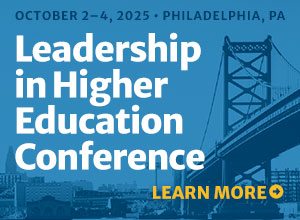If you are a leader in higher education, you can attest that academia can be a little cluttered. The challenges to improving teaching and learning are many as administrators continue to evolve into their roles as institutional leaders. Whether you are a novice or experienced leader, there is always room for improvement and an opportunity for growth. Leadership is a journey, and being an effective leader requires having the proper tools—the right abilities, skills, knowledge, and personal traits—to address the challenges you will face daily. The toolbox is a valuable metaphor for leaders in specific situations. For effective educational leadership, your toolbox will need to contain the following eight items.
Tape: As you enter your role as a leader, you will find broken relationships that require mitigating. To repair these relationships, you will need tape. The tape’s stickiness is the key to its utility and will allow you to hold institutional components together to support the institutional culture and without causing further damage. Effective leaders are cognizant of the importance of building and maintaining sound relationships. It is imperative that leaders spend time focusing efforts in primary areas that will build connections that promote partnerships for the institution externally, as well as internally. Relationships are critical, so make sure that you advocate partnerships as you are leading.
Eye protection: Edgar Allen Poe wrote, “Believe nothing you hear, and only one half that you see.” This is simple but important advice. Especially if you are a new administrator and feeling your way around a new culture and environment, be cautious about the information you take in and put out. If you react to everything you see, you will find yourself with eyes full of debris, unable to navigate or make objective decisions. If that happens, then you will be no good to your organization. As a leader, you engage your eye protection so that you can effectively navigate the path ahead and identify how you will respond to a variety of situations to progress the mission of your institution and student success. While every leader is different, steering clear of debris can assist leaders to be strategic and make well-thought-out decisions.
A flashlight: To navigate institutional cultures and see issues for what they really are, you will need a flashlight. As a higher education leader, you must watch where you step, keeping an eye on the corners when you pull back the layers of unresolved issues. Be aware that politics and personal agendas lurk everywhere at all times, and navigating these issues strategically will assist you in becoming a successful leader. As a leader you must make the decision to play chess or checkers when it comes to being strategic within your organization. Of course, chess is more complex than checkers; it requires more moves and rules. This level of thinking will allow you to be more strategic and methodical in the day-to-day decisions you must make in your institution. Additionally, by using your flashlight, you will be able to plan ahead, strategically think of how to handle the many moving situations ahead of your institution, and find new opportunities for advancing the mission.
Earplugs: Just as your eyes need protection, so will your ears. Many people on campuses work in silos; therefore, you will no doubt hear rumors about the campus, the leadership, and things that occurred in the past with no relevance to where the institution is headed. As an academic leader, you must decide what you need to hear and not hear. In other words, you must make a strategic decision about what you will internalize and not accept into your decision-making processes. You must reframe your actions, thoughts, and words to create positive outcomes for your students. Importantly, you must have hearing protection to block out the noise to be an effective decision-maker. Also, you must have the skills to break down internal silos and encourage collaborative efforts that lead to student success for your institution.
Breathing protection: Often you will witness biologists or chemists wearing respirators to protect against particles, chemicals, gases, or vapors. As a leader in higher education, you will also need to breathe in an environment free of toxins. You must protect your institution from lack of collaboration, communication, and effective policies and processes to move it forward. Be a breath of fresh air to your college or university and bring change, creativity, innovation, and efficiency to your leadership role by removing the toxins from your institutional environment.
Gloves: It is a known fact that true leaders get their hands dirty, so you will need a good pair of gloves. Operating as an administrator in higher education, you will handle challenges from day to day that will be complex, convoluted, and messy. I often say, “As a leader I cannot run from the fire; I must run to it.” Why? How will the fire be extinguished if someone is not willing to put in effort to resolving the burning issue? Therefore, prepare to get your hands in dirty situations as you attempt to resolve conflict and deal with institutional politics. To be clear, higher education organizations can be highly political entities, and your peers’ and subordinates’ wanting the resources to move their agendas exacerbates political conflict. Although organizational politics are inevitable, as a leader you can use your gloves to turn an apparently dirty situation into an innovative solution to ensure that resources are used to promote student success in a collaborative way on your campus.
A hammer: There is no doubt about it: you will need a hammer in your toolbox. When swung, a hammer distributes impact over a small area of an object. As a leader in higher education, you must be able to make such an impact on an institutional level. You must hold individuals accountable, and you will need to come down hard in some of the decisions you make. Some of your decisions may not be the most popular; however, if the results benefit students, then it is acceptable to come down hard with your hammer to make the most impact. As a leader you will make decisions every day, many of which will have an impact on your faculty, staff, and students. Oftentimes you will be required to make major decisions in a short time frame. Understand that it is quite common and acceptable to make quick, on-your-feet decisions. As I often tell my staff, if you make a decision with the benefit of the students, then you will make the right decision. Do not be afraid to use your hammer.
Socket wrench: A socket wrench is a tool I often see my husband use to tighten and loosen a bunch of nuts. Yes, I said it: a bunch of nuts. Although the issues that we work with day-to-day are serious matters, we cannot be uptight and hard on ourselves and others. It is OK to laugh and find the humor in what you do as a leader. I love having a laugh with my subordinates and connecting with them. Research proves that persistent humor at work can help organizations brand themselves, attract employees, improve employee morale, and reduce workplace stress. Additionally, a humor-filled environment can improve employee retention rates and reduce employee absenteeism. Most importantly, humor can improve workplace communication, customer service, and eventually improve productivity. Laugh a little or a lot!
This article first appeared in Academic Leader on July 1, 2019 © Magna Publications. All rights reserved.
Tanjula Petty, EdD, currently serves as the interim assistant provost of academic affairs at Alabama State University, where she also cochairs activities surrounding accreditation.



